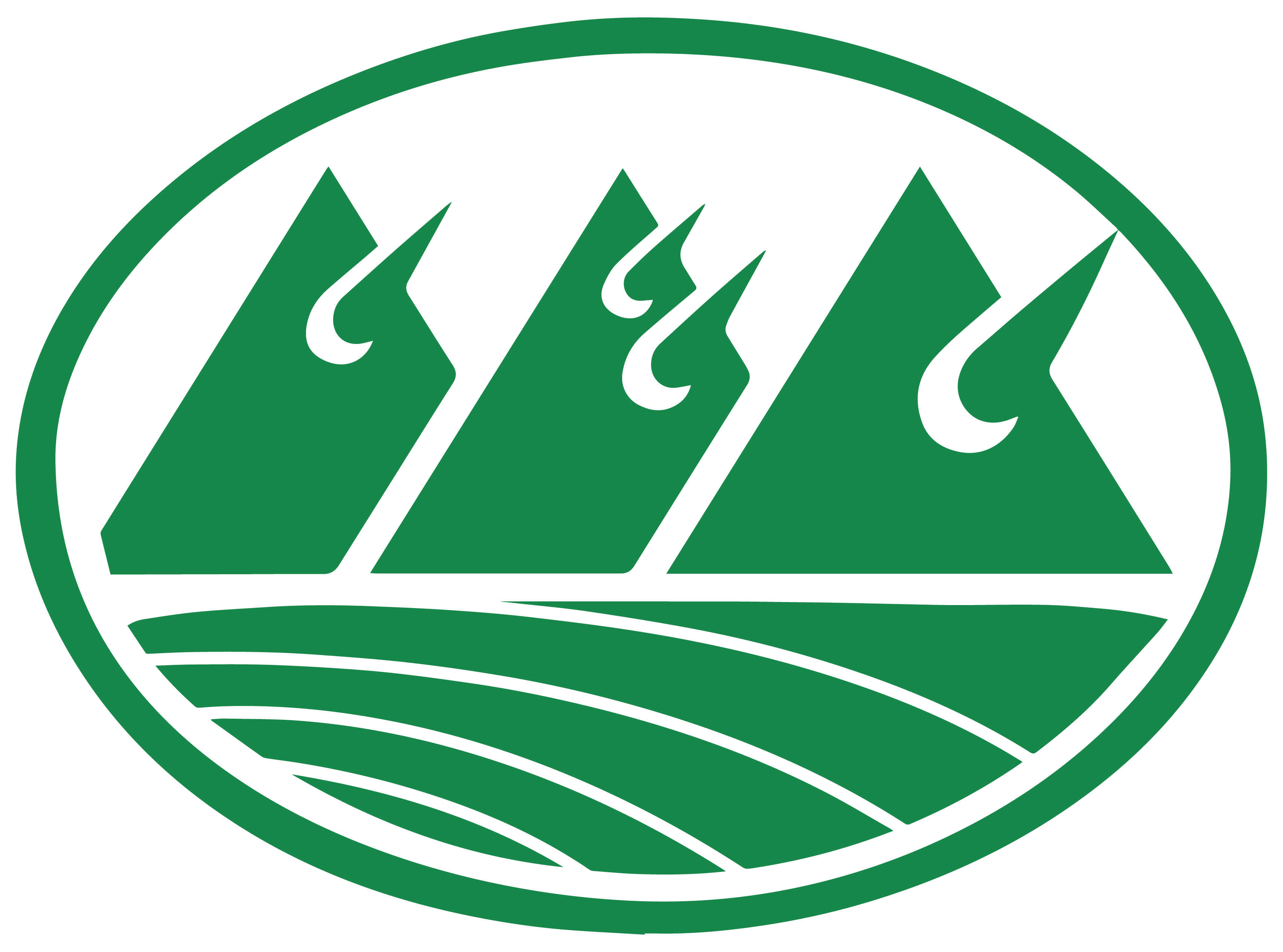Water is Integral
From the days of the ahupuaʻa to the present, we all agree that water is sacred and essential to life. Grove Farm is committed to building a sustainable Kauaʻi and promoting island-enhancing initiatives. In order to have a sustainable island, water is an integral component.
Water has literally flowed through centuries of transition -- from ancient Hawaiʻi, where water provided for farming and family needs, to serving a thriving sugar industry, and to the present where there are many diverse needs. When sugar cane crops were introduced, many changes occurred, all of which shaped the Kauaʻi that exists today.
Maintaining a Legacy
Sugar and pineapple plantations brought in labor from all parts of the world to our island state. As the population grew, it necessitated the need for housing, commerce, education, and other developments. Today, our islands’ basic needs are no different from ancient Hawai‘i, where farming and gathering are still paramount to our existence.
For well over 150 years, Grove Farm has operated, maintained, and enhanced a series of legacy water infrastructure that serves the Kaua‘i community. Given the central location of the Grove Farm lands, this water infrastructure is critical to the island’s sustainability.
The legacy water systems were designed primarily for sugar production by Lihu‘e Plantation, Grove Farm, and Kōloa Plantation. In addition to the agricultural uses, it has also provided drinking water, hydro-electric power production, and irrigation for small farms, biomass producers, the Lihue Airport gateway, commercial areas, and ranching. All of these activities are protected uses under the state Water Code and are also important components in building a sustainable Kauaʻi.
Despite the end of both the pineapple industry and the sugar industry, our island continues to rely on these plantation-era water infrastructure systems to provide for the many needs of today. For that reason, Grove Farm has continued to maintain its valuable water assets, such as reservoirs, streams, tunnels, and other water-related infrastructure.
After the sugar industry closed down, less water was used for agricultural uses and sugar was a “thirsty” crop to grow. Because thousands of acres of sugar cane fields were no longer irrigated, we, unfortunately, lost a great source to recharge our aquifers. Wells did not recharge as they did in the past and sources of potable water literally “dried up." In order to further the state’s goals of food sustainability, Grove Farm has dedicated a total of over 10,500 acres for agricultural use, which means that agriculture is the only use permitted for these lands. By continuing to utilize these arable lands for agricultural purposes, it will recharge our groundwater sources and help prevent unnecessary run-off. It will also move the island toward a more sustainable food future, rather than relying so heavily on importing most of what we eat. |
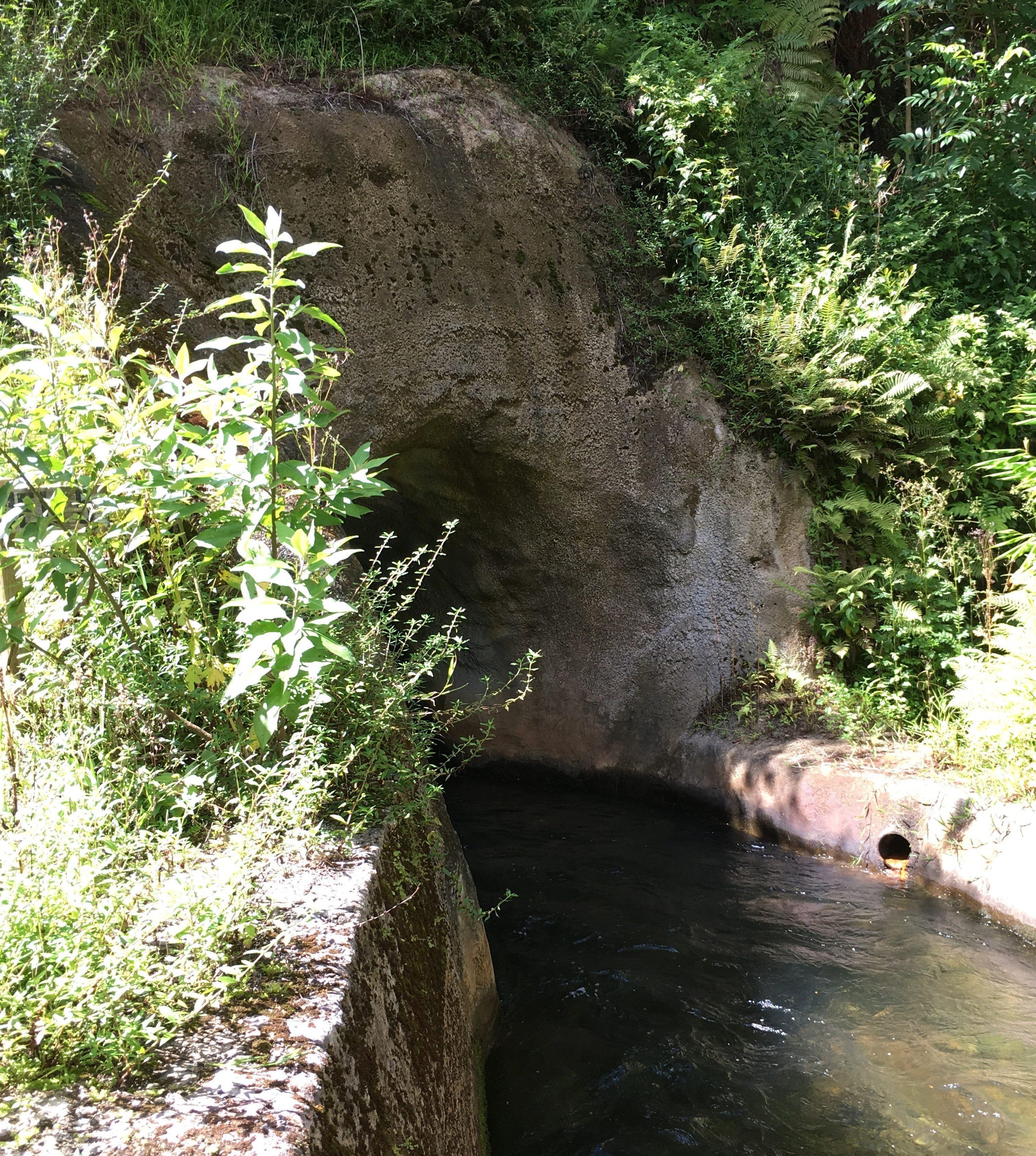
Beneficial Public Uses of Surface Water
For the East Kaua‘i community – whose water comes from the Waiahi and Hanamaʻulu streams – water is critically important to achieve our state goal of increasing local food production and growing what the island eats. In the Lihu‘e area alone, we currently have 3,800 acres in productive agriculture uses. Water is delivered to over 50 tenants, including:
- Ranchers who raise cattle and sheep
- Farmers who raise fruit crops like papaya, lychee, dragon fruit, breadfruit, and mango.
- Farmers who produce a range of vegetables for on-island use as well as export, including ginger, taro, mixed greens
- Firms that grow landscape plants like native species, decorative plants, cut flowers for lei and other uses, and sod for commercial and residential landscaping uses.
Waiahi Surface Water Treatment Plant
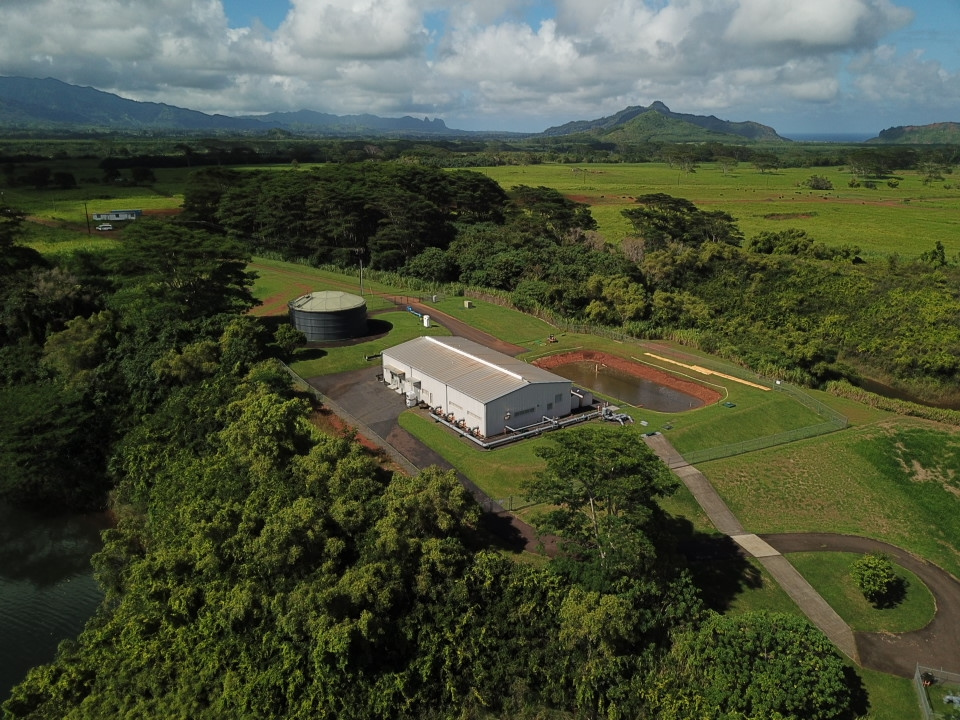
Because of the limited production and questionable reliability of traditional wells, Kauaʻi's sources of potable water dramatically diminished. Back in the late 1990s and early 2000s, Grove Farm began to develop plans, in conjunction with the Kaua‘i Department of Water, to develop the state’s first surface treatment plant. Opened in late 2005, the Waiahi Surface Water Treatment Plant is the island’s most important source of potable water. To date, Grove Farm has invested over $11 million of capital, and the annual operating expenses to run this facility is approximately $1.6 million. The plant currently produces an average of 2.4 million gallons of water daily. The terms of this facility were reviewed and approved by the Board of the Kaua‘i Department of Water in 2004.
Today, 20% of the island’s residents obtain their drinking water from Waiahi. This facility benefits residents in the Hanamaʻulu – Lihuʻe – Puhi – Wailua, and Kapa‘a areas and the businesses and visitor establishments located there.
After the water is processed, extensive testing for water quality is conducted, and the drinking water exceeds all water quality standards parameters. Interestingly, because of Kaua‘i’s geological age – being the oldest of the main Hawaiian Islands -- we have a naturally high level of bauxite in our soils. Bauxite is a source of aluminum, and in the mid-1900s, several businessmen looked into the feasibility of creating an aluminum processing business.
Constant coordination, communication, cooperation, and oversight by the State Department of Health’s Safe Drinking Water Branch and Clean Water Branch, the Kauaʻi Department of Water, and other regulatory oversight departments with Grove Farm is required to deliver safe and quality water from the Waihi Surface Water Treatment Plant. Besides the potable water produced, these water systems also provide non-potable water for irrigation water for many diverse uses and users. Some of the applications are irrigation for the Kaulu I Ka Pono Academy – Kaua‘i’s adolescent treatment center., the State of Hawaiʻi Lihuʻe Gateway Beautification project, the Kauaʻi Community College’s taro loʻi and the Go Farm program, the Vidinha Soccer Fields, the Judiciary Complex, the Kauaʻi Police Department and the State Agribusiness Development Corporation. |
Water was also provided to the Wailua lands owned by the Department of Hawaiian Home Lands and is available when water flows through the plantation irrigation systems.
Grove Farm contracts Aqua Engineers to operate and maintain the facility. The facility operates under stringent guidelines of the Safe Drinking Water Act, the principal federal law in the United States, to ensure safe drinking water for the public. The State of Hawai‘i Department of Health, Safe Drinking Water Branch, administers the federal law, and regulates the Waiahi SWTP.
Here’s more facts about this important facility and the drinking water that it produces:
Is our drinking water safe?
Yes! Constant testing is conducted and the Waiahi SWTP adheres to strict guidelines of the Department of Health – Safe Drinking Water Branch. Drinking water is regulated by the comprehensive set of laws as set forth in the Safe Drinking Water Act. There are many regulations to protect the public that must be adhered to in order to provide safe drinking water for our residents and visitors.
We were told that high levels of aluminum are in our watershed. Is this true?
That is correct. Although our raw water contains high levels of aluminum, the purification process ensures that the drinking water levels are well in compliance with the standards.
Water sources in the Hawaiian Islands are influenced by volcanic soils,some of which are naturally rich in deposits of bauxite, a rock composed mainly of aluminum-bearing minerals. The United States Geological Survey (USGS) has studied the presence of bauxite on Kaua`i and reports that the bauxite has formed by weathering of basalt of the Kōloa Volcanic Series. The raw water is filtered through the ultra-filtration membrane process which removes silt, pathogens, and bacteria. The clean water is further disinfected and delivered to Puhi, Lihu‘e, Hanama‘ulu, Wailua and Kapa‘a.
Is aluminum a contaminant?
No, aluminum is not considered a “Primary” contaminant under the Safe Drinking Water Act. Aluminum is regulated by “Secondary” standards under the Safe Drinking Water Act. Secondary standards are established as guidelines to assist public water systems in managing their drinking water for aesthetic considerations, such as taste, color, and odor.
Is aluminum added to the water purification process?
Aluminum is not added. However, a coagulant, aluminum chloralhydrate (ACH), is added to the raw water prior to the membrane filtration process. The coagulant reacts with the raw water to remove harmful pathogens and bacteria particles through the filtration process. ACH is the standard coagulant for drinking water membrane filtration plants, is required by the Hawai`i Department of Health, and it meets the certification requirement in National Sanitary Foundation Standard 61.
A coagulant must be added to the surface water treatment process when processing the drinking water. It is usually in an aluminum- or iron-based form. We use aluminum chlorohydrate (ACH), since aluminum is the one element that is most abundant in the earth’s crust – it is part of us – just like iron. The FDA recognizes ACH as aluminum-based salts, which are widely used in water purification to remove dissolved organic material.
Is the ACH added for coagulation a cause for concern in my drinking water?
No. In fact, the aluminum-based coagulant that is required to be added to the treatment process is designated NSF Certified. This means that it has been certified by NSF International, formerly the National Sanitation Foundation, to be safe for consumers. NSF International develops public health standards and certification programs to protect the world’s food, water, consumer products and improve global health.
What happens to the ACH, pathogens, silt and bacteria?
The membrane filters allow only clean water to pass though, making the purified drinking water free of contaminants. The coagulated material, including ACH, pathogens, silt and bacteria, collects on the outside of the membranes and is regularly backwashed. The backwash water is then pumped from the plant to a detention basin where the solids settle. After settling, the clarified water is returned to the Kapaia Reservoir. Only about ten percent of the water that is drawn into the facility is returned to the Kapaia Reservoir. This is water from the backwash of the membranes and other operations of the facility.
Is the discharge water harmful to the environment?
No. In the 15 years of operating the facility, we have passed all toxicity testing – all results have been meeting the standards 100% of the time! The discharge is carefully monitored by the State of Hawai‘i Department of Health – Clean Water Branch. The Clean Water Act exists to protect waterways from becoming toxic environments for aquatic life and to protect our environment.
Regular testing is done of the discharge water to ensure that the water is within acceptable levels for specific elements. In times of adverse weather conditions, we do experience spikes in turbidity and more suspended solids. Due to the high levels of naturally occurring aluminum in the raw water, we have implemented practices to prolong settling of the solids.
Can you explain more about the discharge water?
In general, the water that is returned to the reservoir is cleaner than the intake water. With heavy rainfall, the water contains high levels of turbidity. As you know, Kaua‘i is blessed with abundant rainfall and we are constantly susceptible to weather conditions. Therefore, we will be installing larger holding ponds to allow longer settling times prior to returning the water to the Kapaia Reservoir. This capital project is expected to cost $2.6 million, which will be cost shared with the Department of Water, and will be completed by December 2022.
Another standard for the discharge water is Dissolved Aluminum which the standard is set at 260 micrograms per liter. In all testing to date, the actual Dissolved Aluminum levels have always been reported by an independent laboratory as “non-detectable.”
What is a microgram per liter?
One microgram is equivalent to one part per billion. It is equivalent to one second in nearly 32 years or one sheet in a roll of toilet paper stretching from New York to London!
Why was the Waiahi Surface Water Treatment Plant built in the first place?
In the sugar plantation era, Kauaʻi’s abundant supply of water was used to irrigate thousands of acres of sugar cane. Fresh water aquifers benefited as they were recharged at a rate that was sustainable with Kauai’s demand.
As sugar plantations began closing, aquifers were recharged at a much slower rate. It is also believed that over pumping to supply population and tourism increases also contributed to aquifer depletion. And, Kauai’s geology generally has a low percolation rate and is not as conducive to aquifer recharge as the younger Hawaiian Islands.
This resulted in the aquifers no longer being able to keep up with Kauai’s demand and were being depleted. Hence, the Waiahi Surface Water Treatment plant was built in 2005. This state-of-the-art facility processes potable water for Puhi, Līhu‘e, Hanama‘ulu, Wailua and Kapa‘a – major areas of Kaua’i.
Grove Farm has been accused of “selling water” which is a public trust issue. Is this true?
No. The Public Trust Doctrine provides for the protection of water for purposes, including domestic water use of the general public, particularly drinking water.
From a financial standpoint, the agreement between Grove Farm and the Department of Water enables Grove Farm to be reimbursed for expenses required to produce potable water plus a return on two-thirds of the plant investment, which is about $12.9 million as of mid-year 2020. Just to process the raw water into drinking water costs an average of $1.6 million a year. Based on the average demand of 2.4 million gallons per day, the DOW pays $1.6 million, which just covers expenses. At those levels, no return is being made.
Grove Farm is certainly not in the business of “selling water.” Rather, it was a responsibility we accepted to develop this critical water source, storage and transmission to provide homes and commercial and industrial opportunities in the Puhi – Lihuʻe - Hanamaʻulu area. Think about it – what would happen if this vital water purification facility were not around today?
An educational center for our keiki to learn:
The Waiahi SWTP is an educational learning center for our keiki. Students continue to visit the site through the Grove Farm Educational Modules program to learn about the membrane filtration system and to expand their minds on the importance for building a sustainable Kaua‘i. Our keiki learn that this Waiahi SWTP is one of the most critical infrastructure items for all of Kaua‘i.
Adam Killerman - AJAR Inc.
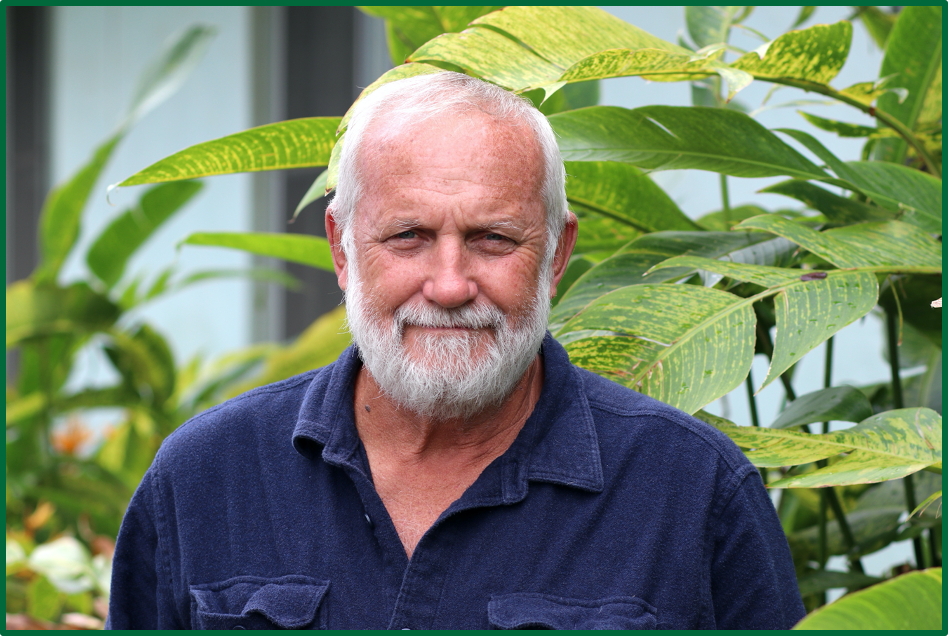 | Most of us will hunker down and stay indoors during adverse weather conditions. For Adam Killerman and his crew, it means heading to the mountains to monitor water levels in ditches, streams, and reservoirs and taking necessary action, if needed. After graduating with his degree in Tropical Agriculture, Adam worked for McBryde Sugar Plantation as an Agricultural Assistant, where he did a lot of work in irrigation. He was promoted to Crop Control Superintendent, where he created schedules for sugar cane harvesting, fertilizing, and other crop functions. He ended his 18-year career with the plantation, the last seven years as the Irrigation Superintendent. When McBryde closed its sugar operations, Adam was managing 7,000 acres of irrigated lands from Eleʻele to Kōloa to Haiku. |
He recalls working under his supervisor, Jacki Urata, who gave him valuable advice about irrigation. "Don't ever assume. Do you know what happens when you assume? Always check your water." Urata always taught the value of doing a job the right way the first time, instead of being reactive and waiting until pipes explode to do something. "Those old-timers were very generous with their knowledge," Killerman said. "They were excellent teachers."

After McBryde Plantation closed down, he saw a need to keep the island’s water systems maintained for the future of Kauaʻi's agriculture industry. Adam started AJAR Inc. in 1996 and has been maintaining reservoirs, ditches, and streams for companies such as Grove Farm.
The biggest job he and his 11 workers have is weed control around the waterways. It's a necessity to keep the guinea grass down because the vegetation clogs up the canals and tunnels. They also mow the walls and sides of the reservoir to make it easier to spot any leaks or potential breaches in them. The invasive Albizia tree is also a problem. "After big rains, you see Lydgate and Wailua river bring all the wood down from the mountains. Thatʻs all albizia trees." Killerman said. “I couldnʻt do this work without my employees. They work in the worst conditions and it’s a constantly changing job. They do a lot and I appreciate every one of them.”
AJAR also repairs water infrastructure such as irrigation lines, flumes, ditches, and they constantly monitor stream flows. Keeping a close eye on weather conditions, when a storm is imminent, Adam’s crew will lower the water levels in reservoirs and clears waterways of any blockages. Even when itʻs storming, they have to open and close gates as necessary to keep water at a controlled level. "We're out there always watching to bring the amount of water we need," he said. "We make sure we're not wasting water either. Today, we're only using a third of what sugar used. We aren't taking much in comparison." | 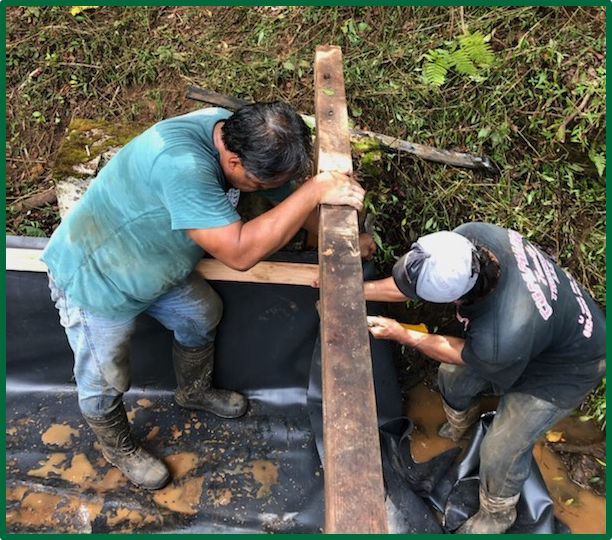 |
The value of Adam and the entire AJAR Inc. team was clearly evident during the last weekend of March. With the heavy deluge of rain on Friday night and early Saturday morning, our ditches, flumes, waterways, and reservoirs quickly filled up. A couple of our larger reservoirs saw their water heights increase by 10’ in just a couple of hours – resulting from the staggering amount of intense rainfall in a short period of time. |
In recent years, we have noticed that many invasive albizia trees have fallen due to their weak properties, which stress the need to remove and control this harmful species. Kauaʻi is fortunate that Green Energy Kauaʻi is harvesting thousands of acres of albizia for their biomass feedstock to produce electricity in the Haiku area near the Halfway Bridge. We benefit from this renewable energy source plus the environment benefits by removing this invasive plant. We salute our AJAR Inc. team for their outstanding work. Due to their efforts, the critical surface water source – the Kapaia Reservoir – was fully operational on Saturday, continuing to provide about 20% of the island's drinking water. 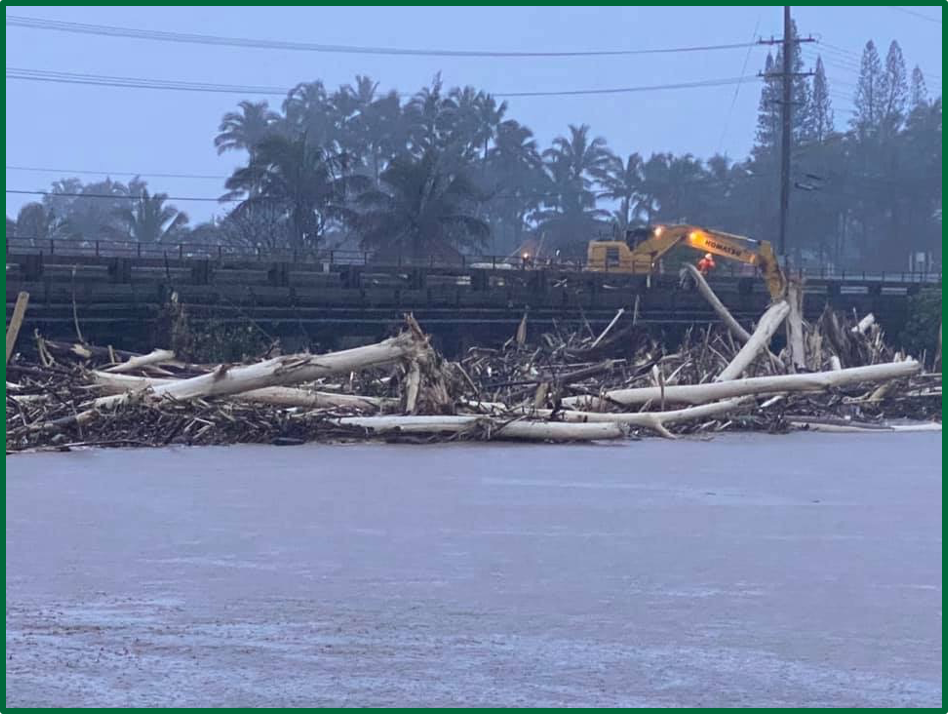 | 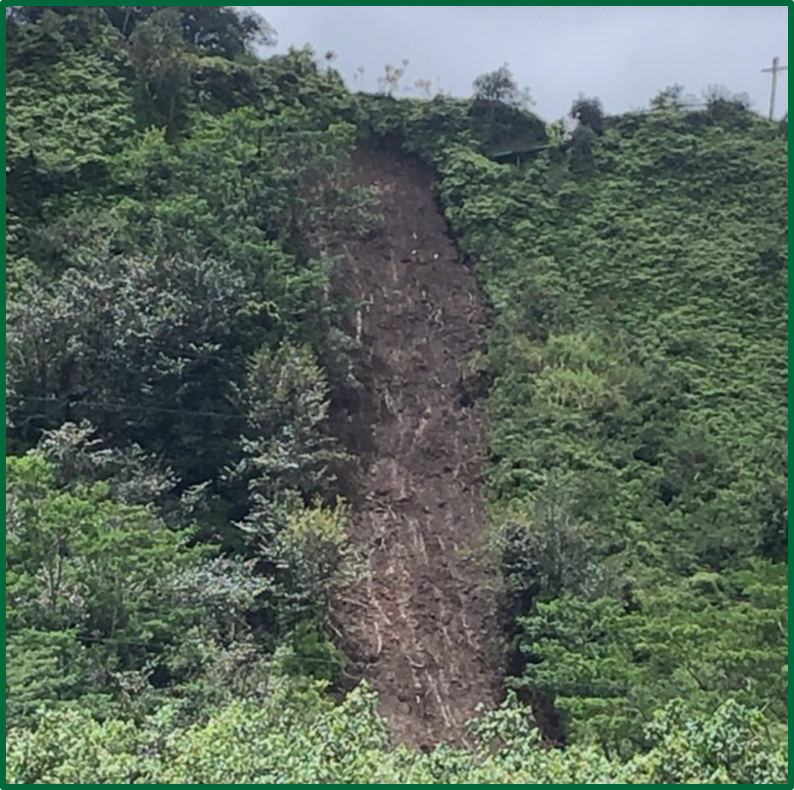 |
Flooding and invasive albizia damage to Wailua Beach and Lydgate Park
Socio-Economic Ripple Effect of Water
The direct impact of water to all living things is not as evident as its impact on the socio-economic welfare of the people. But if you look closer, there is a ripple effect when businesses are impacted. These water systems are used by entities such as the KIUC Kapaia Power Station and for Global Algae Innovations. Water in the irrigation ditch system is essential for ecotourism activities for Kaua‘i Backcountry Adventures. These entities employ many residents. These businesses have met the public use needs of our island, have positively contributed to sustainable water for Kaua‘i, and have met the demands of tourists for activities that combine sustainable practices with our island’s rich culture and history.
Many State, County, and private businesses are jointly working to provide our island’s potable and non-potable water requirements. This joint public-private partnership is working well and should be perpetuated, with the proper oversight that exists today.
Other Sustainability Initiatives
Grove Farm's vision is to build a sustainable Kauaʻi by being a leader in social entrepreneurship and island-enhancing activities while remaining deeply committed to preserving the island's cultural and historical linkages - whether it be through the preservation of historic sites, promoting alternative energy sources, supporting agriculture and food production, education and propagation of plants, encouraging a healthy lifestyle or protecting water sources.
Learn about other initiatives